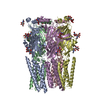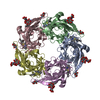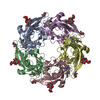+ Open data
Open data
- Basic information
Basic information
| Entry | Database: PDB / ID: 8aw2 | ||||||
|---|---|---|---|---|---|---|---|
| Title | Mouse serotonin 5-HT3A receptor in complex with vortioxetine | ||||||
 Components Components | 5-hydroxytryptamine receptor 3A | ||||||
 Keywords Keywords |  MEMBRANE PROTEIN / Pentameric ligand-gated ion channel / MEMBRANE PROTEIN / Pentameric ligand-gated ion channel /  Serotonin receptor / vortioxetine Serotonin receptor / vortioxetine | ||||||
| Function / homology |  Function and homology information Function and homology informationNeurotransmitter receptors and postsynaptic signal transmission / serotonin-gated monoatomic cation channel activity / serotonin-activated cation-selective channel complex / serotonin receptor signaling pathway /  serotonin binding / inorganic cation transmembrane transport / acetylcholine-gated monoatomic cation-selective channel activity / serotonin binding / inorganic cation transmembrane transport / acetylcholine-gated monoatomic cation-selective channel activity /  cleavage furrow / ligand-gated monoatomic ion channel activity involved in regulation of presynaptic membrane potential / cleavage furrow / ligand-gated monoatomic ion channel activity involved in regulation of presynaptic membrane potential /  presynaptic membrane ...Neurotransmitter receptors and postsynaptic signal transmission / serotonin-gated monoatomic cation channel activity / serotonin-activated cation-selective channel complex / serotonin receptor signaling pathway / presynaptic membrane ...Neurotransmitter receptors and postsynaptic signal transmission / serotonin-gated monoatomic cation channel activity / serotonin-activated cation-selective channel complex / serotonin receptor signaling pathway /  serotonin binding / inorganic cation transmembrane transport / acetylcholine-gated monoatomic cation-selective channel activity / serotonin binding / inorganic cation transmembrane transport / acetylcholine-gated monoatomic cation-selective channel activity /  cleavage furrow / ligand-gated monoatomic ion channel activity involved in regulation of presynaptic membrane potential / cleavage furrow / ligand-gated monoatomic ion channel activity involved in regulation of presynaptic membrane potential /  presynaptic membrane / presynaptic membrane /  postsynaptic membrane / neuron projection / postsynaptic membrane / neuron projection /  axon / neuronal cell body / glutamatergic synapse / axon / neuronal cell body / glutamatergic synapse /  synapse / identical protein binding synapse / identical protein bindingSimilarity search - Function | ||||||
| Biological species |   Mus musculus (house mouse) Mus musculus (house mouse) | ||||||
| Method |  ELECTRON MICROSCOPY / ELECTRON MICROSCOPY /  single particle reconstruction / single particle reconstruction /  cryo EM / Resolution: 3.01 Å cryo EM / Resolution: 3.01 Å | ||||||
 Authors Authors | Lopez-Sanchez, U. / Nury, H. | ||||||
| Funding support | European Union, 1items
| ||||||
 Citation Citation |  Journal: Nat Struct Mol Biol / Year: 2024 Journal: Nat Struct Mol Biol / Year: 2024Title: Structural determinants for activity of the antidepressant vortioxetine at human and rodent 5-HT receptors. Authors: Uriel López-Sánchez / Lachlan Jake Munro / Lucy Kate Ladefoged / Anders Juel Pedersen / Christian Colding Brun / Signe Meisner Lyngby / Delphine Baud / Céline Juillan-Binard / Miriam ...Authors: Uriel López-Sánchez / Lachlan Jake Munro / Lucy Kate Ladefoged / Anders Juel Pedersen / Christian Colding Brun / Signe Meisner Lyngby / Delphine Baud / Céline Juillan-Binard / Miriam Grønborg Pedersen / Sarah C R Lummis / Benny Bang-Andersen / Birgit Schiøtt / Christophe Chipot / Guy Schoehn / Jacques Neyton / Francois Dehez / Hugues Nury / Anders S Kristensen /     Abstract: Vortioxetine (VTX) is a recently approved antidepressant that targets a variety of serotonin receptors. Here, we investigate the drug's molecular mechanism of operation at the serotonin 5-HT receptor ...Vortioxetine (VTX) is a recently approved antidepressant that targets a variety of serotonin receptors. Here, we investigate the drug's molecular mechanism of operation at the serotonin 5-HT receptor (5-HTR), which features two properties: VTX acts differently on rodent and human 5-HTR, and VTX appears to suppress any subsequent response to agonists. Using a combination of cryo-EM, electrophysiology, voltage-clamp fluorometry and molecular dynamics, we show that VTX stabilizes a resting inhibited state of the mouse 5-HTR and an agonist-bound-like state of human 5-HTR, in line with the functional profile of the drug. We report four human 5-HTR structures and show that the human receptor transmembrane domain is intrinsically fragile. We also explain the lack of recovery after VTX administration via a membrane partition mechanism. | ||||||
| History |
|
- Structure visualization
Structure visualization
| Structure viewer | Molecule:  Molmil Molmil Jmol/JSmol Jmol/JSmol |
|---|
- Downloads & links
Downloads & links
- Download
Download
| PDBx/mmCIF format |  8aw2.cif.gz 8aw2.cif.gz | 567.5 KB | Display |  PDBx/mmCIF format PDBx/mmCIF format |
|---|---|---|---|---|
| PDB format |  pdb8aw2.ent.gz pdb8aw2.ent.gz | 383.3 KB | Display |  PDB format PDB format |
| PDBx/mmJSON format |  8aw2.json.gz 8aw2.json.gz | Tree view |  PDBx/mmJSON format PDBx/mmJSON format | |
| Others |  Other downloads Other downloads |
-Validation report
| Arichive directory |  https://data.pdbj.org/pub/pdb/validation_reports/aw/8aw2 https://data.pdbj.org/pub/pdb/validation_reports/aw/8aw2 ftp://data.pdbj.org/pub/pdb/validation_reports/aw/8aw2 ftp://data.pdbj.org/pub/pdb/validation_reports/aw/8aw2 | HTTPS FTP |
|---|
-Related structure data
| Related structure data |  15689MC  8axdC  8bl8C  8blaC  8blbC M: map data used to model this data C: citing same article ( |
|---|---|
| Similar structure data | Similarity search - Function & homology  F&H Search F&H Search |
- Links
Links
- Assembly
Assembly
| Deposited unit | 
| ||||||||||||||||||||||||||||||||||||||||||||||||||||||||||||||||||||||||||||||||||||||||||||||||||||||||||||||||||||||||
|---|---|---|---|---|---|---|---|---|---|---|---|---|---|---|---|---|---|---|---|---|---|---|---|---|---|---|---|---|---|---|---|---|---|---|---|---|---|---|---|---|---|---|---|---|---|---|---|---|---|---|---|---|---|---|---|---|---|---|---|---|---|---|---|---|---|---|---|---|---|---|---|---|---|---|---|---|---|---|---|---|---|---|---|---|---|---|---|---|---|---|---|---|---|---|---|---|---|---|---|---|---|---|---|---|---|---|---|---|---|---|---|---|---|---|---|---|---|---|---|---|---|
| 1 |
| ||||||||||||||||||||||||||||||||||||||||||||||||||||||||||||||||||||||||||||||||||||||||||||||||||||||||||||||||||||||||
| Noncrystallographic symmetry (NCS) | NCS domain:
NCS domain segments:
|
 Movie
Movie Controller
Controller







 PDBj
PDBj

